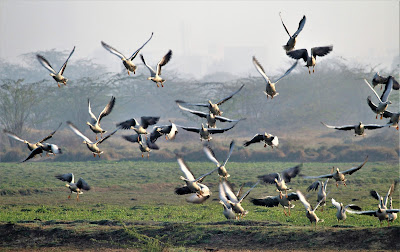Today when I visited the Basai Wetland in Gurgaon, I was in for a surprising entertainment that proves that the Wetland has been here for years and is not the result of water seepage from a water pipeline. The moment I got off my bike, was riveted by the sight of the carcass of a fish at least one and a half foot long! It must have taken the fish quite a few years to reach that length. This proves that the Basai Wetland in Gurgaon supports aquatic life forms, and has been doing so for many many years! It would be a great tragedy to lose such a valuable treasure, an ecosystem that supports avian and aquatic life!
I was also surprised to hear a few men shouting their heart out! Puzzled by this performance I decided to investigate. Strangest of all things, I noticed a man in a boat, driving away the birds.
Next, I saw men on the dykes and banks driving away the birds. When I went ahead, I came across a man who was yelling on top of his voice even as he made a show of flinging stones at the birds in the vicinity. I stopped next to him and asked him if he was in pain. Surprised, he told me that they were driving away the birds so that they could gather the fish that had accumulated in the dwindling water (since the authorities were draining out the wetland to make way for a waste treatment plant). I was dumbfounded by his reply! So now even the fish, frogs and freshwater turtles are under threat! Strangely enough, I could see fish jumping out of the shallow water in a desperate struggle to survive.

I wonder who owns the fish, and what right these men had of driving away the migratory birds that settle on the wetland to nest during the winter season. Anyways, these men were running along like mad people shouting and roaring at the birds, too much effort I believe for a few kilos of fish, or perhaps, was it much more? The presence of fishing nets and makeshift barricading is proof enough that fishing takes place in the Basai Wetland!
The Basai Wetland is an important ecosystem that supports not only aquatic and avian life, but also people who depend on it for an important form of protein in the form of fish that they catch. Besides, the wetland is surrounded by patches of farmland that seem to be fertile enough for wheat to be grown. I was in for a surprise when I found a herd of geese perched on a piece of land on which a crop of wheat was standing.
It is high time we thought about sustainable development and not rampant and unplanned development. In our folly, we have already lost many of our wetlands. Today our groundwater levels are receding at an alarming rate. When we destroy our wetlands, we destroy nature's ability to recharge depleting groundwater levels.
Ibis feed on fish. Mallards, pochards, feed on fish. Human beings feed on fish. A wetland supports a whole ecosystem that is finely balanced. The proof that the Basai Wetland is not an accidental pond created from leaking water-pipelines is there before us! It will be a great tragedy to lose the remaining wetland in Gurgaon!




































